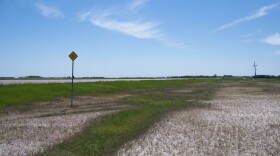-
No doubt many of you heard the recent news that “Wicked: For Good” star Jonathan Bailey was named People magazine’s Sexiest Man Alive for 2025. Okay... But what species would you select to be the most attractive small mammal in North Dakota?
-
Turtle Mountain, straddling the Canada-United States border in Bottineau and Rolette counties, is often referred to as a “forested island in a grassland sea.” Because Turtle Mountain lies around 600-800 feet above the surrounding prairie, an orographic effect results in a notable increase in the effective precipitation on Turtle Mountain, resulting in conditions favorable to forest development.
-
November is here! We generally think of September, October, and November as fall — and with winter waiting in the wings, the animals have basically three options: migrate, hibernate, or stay and endure it. And the plants have no choice but to stay and endure the winter.
-
Several owl species nest in North Dakota, but their eerie calls and nighttime habits have inspired centuries of myths and legends — from wise protectors to harbingers of doom.
-
There is a new moon coming up on October 21, and you know what that means! It is prime time for some stargazing, plus there are a couple meteor showers putting on their annual show.
-
If you have been around the woods and thickets across the state over the past few weeks, a couple of interesting vines may have caught your attention. Neither species is well-known, but nonetheless, they put on an interesting show this time of year.
-
Most everyone in our region knows that the Red River forms a border between North Dakota and Minnesota. However, it might surprise you that the Red River does not delineate the entire eastern border.
-
A couple miles east of Bottineau, North Dakota, on the curve of Highway 5, there’s a sign in the ditch that says “quicksand.” It has been there for decades. I assume it’s a warning not to put your car in the ditch there. But if you do, particularly if you have been watching some old westerns on TV, don’t wait for the Lone Ranger to save you from quickly sinking into eternity. Actually, you probably wouldn’t need him anyway.
-
“What was that?!” That was my first thought many years ago when, walking through some low prairie, something that I could only describe as a mouse-sized kangaroo took three big leaps out of the grass in front of me. I was to learn later that it was a jumping mouse!
-
I used to occasionally hear one of my college professors call out the names of some plants as he drove down the highway at 60 miles per hour. “That is a 60 mile-an-hour plant,” he would declare. One of those plants was curly dock, also known as curled dock, sour dock, or yellow dock.
Play Live Radio
Next Up:
0:00
0:00
Available On Air Stations










